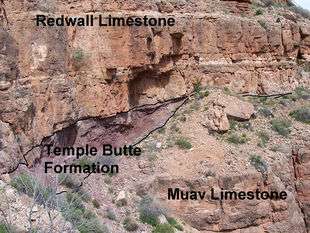Temple Butte Limestone
| Temple Butte Limestone Stratigraphic range: Middle to Late Devonian[1][2] 409–363 Ma | |
|---|---|
 | |
| Type | Geological formation |
| Underlies | Redwall Limestone |
| Overlies | Muav Limestone |
| Thickness | 100 feet (30 m), at maximum |
| Lithology | |
| Primary | dolomite |
| Other | sandstone, mudstone, and limestone |
| Location | |
| Region |
Northern Arizona (Grand Canyon), central Arizona & (southern) Nevada |
| Country | United States of America |
| Type section | |
| Named for | Temple Butte, Coconino County, Arizona.[3] |
| Named by | Walcott (1889)[3] |
The Devonian Temple Butte Limestone outcrops through most of the Grand Canyon, Arizona, USA; it also occurs in southeast Nevada. Within the eastern Grand Canyon, it consists of thin, discontinuous lenses, and relatively inconspicuous lenses that fill paleovalleys cut into the underlying Muav Limestone. Within these paleovalleys, it at most, is only about 100 feet (30 m) thick at its maximum. Within the central and western Grand Canyon, the exposures are continuous. However, they tend to merge with cliffs of the much thicker and overlying Redwall Limestone.[1][4]
Within the western and central parts of the Grand Canyon, the Temple Butte Limestone consists of a westward thickening layer of interbedded dolomite, sandy dolomite, sandstone, mudstone, and limestone that vary in color from purple, reddish-purple, dark gray, to light-gray. Within the eastern part of the Grand Canyon, the Temple Butte Limestone fills shallow paleovalleys, which are eroded into the underlying Tonto Group. The Temple Butte strata filling these paleovalleys consist of interbedded mudstone, sandstone, dolomite, and conglomerate – that vary in color from purple, reddish-purple, to light gray. Typically, the paleovalley-fill consists of a distinct pale, reddish purple dolomite or sandy dolomite. These paleovalleys range in depth from as much as 100 feet (30 m), to as shallow as 40 feet (12 m).[1][2][4]
The upper and lower contacts of the Temple Butte Limestone are major unconformities. Within the Grand Canyon region, its base is a major unconformity within the Paleozoic rock record. The time represented by this unconfomity spans about 100 million years, including part of Late Cambrian, all of Ordovician and Silurian, and most of Early and Middle Devonian time. The upper contact is a disconformity that typically consists of nearly horizontal surfaces with little or no relief and overlain locally by a basal conglomerate within the overlying Redwall Limestone.[1][2][4]
Within the area of Frenchman Mountain, Clark County, Nevada, over 2,000 feet (610 m) of limestone and dolomite occupy the interval between the Muav and Redwall limestones, where in the Grand Canyon there exists less than 100 feet (30 m) of Temple Butte limestone. These limestone and dolomite beds represent sediments that accumulated during the period of time represented by the two disconformities that from the upper and lower contacts of the Temple Butte Limestone in the Grand Canyon.[1][5]
Geologic sequence
Sequence of Lower to Middle Paleozoic Strata:[6]
- (1)-Temple Butte Limestone, Devonian-(409-363 Ma), channel deposits upon Muav Limestone
- (major) unconformity-(505-409 Ma, or ~100 million years)
(Late Cabrian, all of Ordovician & Silurian, and Early & Middle Devonian) - Tonto Group (~544-505 Ma)
- 3-Muav Limestone (~517-505 Ma)
- 2-Bright Angel Shale
- 1-Tapeats Sandstone (~544-~530 Ma)-(million years ago)
See also
| Wikimedia Commons has media related to Temple Butte Limestone. |
References
- 1 2 3 4 5 Beus, SS (2003) Temple Butte Formation. in: Beus, S.S., Morales, M., eds., pp. 107-117, Grand Canyon Geology. Oxford University Press, New York.
- 1 2 3 Anonymous (2006e) Temple Butte Limestone. Stratigraphy of the Parks of the Colorado Plateau. U.S. Geological Survey, Reston, Virginia.
- 1 2 Walcott, CD (1889) A Study of a Line of Displacement in the Grand Canyon of the Colorado in Northern Arizona. Geological Society of America Bulletin. vol. 1:49-64.
- 1 2 3 Billingsley, GH (2000) Geologic Map of the Grand Canyon 30’ X 60’ Quadrangle, Coconino and Mohave Counties, Northwestern Arizona. Geologic Investigations Series no. I–2688. U.S. Geological Survey, Reston, Virginia.
- ↑ Shelton, JS (1966) Geology Illustrated. Freeman, San Francisco, California. 434 pp. ISBN 978-0716702290
- ↑ Chronic, H (1983) Roadside Geology of Arizona. The Mountaineers Books, Seattle, Washington. (softcover, ISBN 978-0-87842-147-3)
Popular Publications
- Blakey, R, and W Ranney (2008) Ancient Landscapes of the Colorado Plateau. Grand Canyon Association, Grand Canyon Village, Arizona. 176 pp. ISBN 978-1934656037
- Chronic, H (1983) Roadside Geology of Arizona. 23rd printing, Mountain Press Publishing Company, Missoula, Montana. 332 pp. ISBN 978-0-87842-147-3
- Lucchitta, I (2001) Hiking Arizona's Geology. Mountaineers's Books, Seattle Washington. 290 pp. ISBN 0-89886-730-4
External links
- Abbot, W, (2001) Revisiting the Grand Canyon – Through the Eyes of Seismic Sequence Stratigraphy. Search and Discovery Article # 40018, America Association of Petroleum Geologists, Tulsa, Oklahoma.
- Baker, R. G. (1984) Channel filled by Temple Butte Limestone. Iowa Digital Library, University of Iowa, Des Moines, Iowa.
- Mathis, A., and C. Bowman (2007) The Grand Age of Rocks: The Numeric Ages for Rocks Exposed within Grand Canyon, Grand Canyon National Park, Arizona, National Park Service, Grand Canyon National Park, Arizona.
